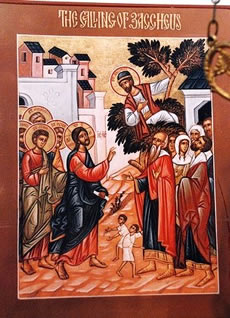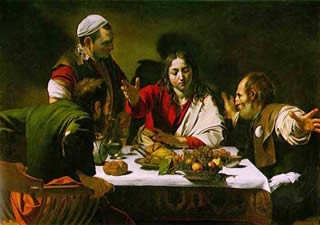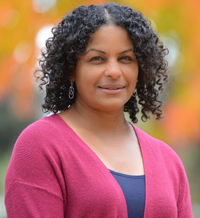"The Son of Man Came to Seek and to Save the Lost"
Reformation Sunday
Guest essay by Helen B. Brooks, Department of English at Stanford University.
For Sunday October 31, 2010
Lectionary Readings (Revised Common Lectionary, Year C)
Habakkuk 1:1–4; 2:1–4 or Isaiah 1:10–18
Psalm 119:137–144 or Psalm 32:1–7
2 Thessalonians 1:1–4, 11–12
Luke 19:1–10
The gospel for Reformation Sunday from Luke 19:1–10 perfectly captures the essence of the Protestant Reformation, namely, that Christ meets you where you are, and that you need no intermediaries between yourself and a remote God. Whereas Zacchaeus, a rich tax collector, climbed up into the sycamore tree in order to see Jesus because of the crowd and because he was short of stature, Jesus calls to Zacchaeus and tells him to come down from the tree, for “I must stay at your house today.” Zacchaeus immediately descends from the tree and “received [Jesus] joyfully,” with the words: “Behold, Lord, the half of my goods I give to the poor, and if I have defrauded any one of anything, I restore it fourfold.”
 |
Icon of Jesus and Zacchaeus. |
Jesus responds: “Today salvation has come to this house. . . . For the Son of man came to seek and to save the lost.” Notice that Jesus has “appeared” freely to Zacchaeus and the crowd, without any intermediaries or conditions. We are also told that the crowd was “open” to the words of Jesus, because “they supposed the kingdom of God was to appear immediately.” (19:11).
How should we conceive of “the kingdom of God” in this story? There are multiple ways to answer this question. I would like to offer one response to the reading that is contextualized by some of the key historical events surrounding the Protestant Reformation.
First and foremost, we are told that Martin Luther, one of the leading theologians in the Reformation movement, who posted his “Ninety-five Theses” on the castle church door in 1517, is most often credited with formally launching the Protestant Reformation. But it is important to recognize that, at the same time, other changes were occurring, some of which were profound, and that figured significantly not only in the orientation of the Reformation but also in the biblical readings marked for Reformation Sunday, and in particular the Gospel of Luke. The Reformation was the product of a long series of historical events, too numerous to outline here, but those events that cast a thought-provoking light on the readings for Reformation Sunday are events that figure significantly in breaking down the boundaries between the heavenly and the worldly, between the spiritual and the secular, and between the public and the private, so that we can better grasp the “in-breaking” of Jesus into the worldly space that Zacchaeus occupies.
An interesting side note to the Gospel reading for Reformation Sunday: Christ’s “reformation” of the financial practices of Zacchaeus, a tax collector, meshes well with at least part of the impetus behind the Reformation and the reforming of some of the monetary practices for which the early Catholic Church was being criticized.
What are some of these key historical events and how can they help us to better grasp the richness of the Reformation Sunday readings? The dominant medieval paradigm rested on a “closed world” cosmology and “fixed” conceptions of the human, fostered in part by a hierarchical and centralized religious authority, lack of instrumentation, and an uneducated populace. But multiple events were at work to challenge that model and to give rise to the advent of the early modern world and its “open” orientation, subject now to a growing — and even competing — range of perspectives.
Among these events we find the decline of feudalism and the inception of capitalism; developments in ship-building and navigational instruments, leading to the expansion of trade and colonialism and contact with previously “unknown” cultures; the rise of universities and a growing educated populace; the revival of classical thought (e.g. Plato and Aristotle) and the Humanist movement with its refocus on the individual, on experience, and on this world; and perhaps of most significance, the invention of moveable type in the early fifteenth century and the printing of the Bible and the broad dissemination of ideas; and, of course, the theoretical writings of Copernicus and, later, Galileo’s empirical observations with the aid of the telescope, which decisively challenged the “closed world” and heliocentric cosmology, launching an “open” and even infinite cosmology, or what today we term our “globalized world,” fostered increasingly by developments in technology.
Accompanying all of these changes was the rise of empiricism, or a challenge to received truths and established authorities, which had marked the dominant medieval paradigm. With the rise of universities, the printing press, contact with other cultures, and instrumentation, centralized authority was undeniably challenged, even though we should pause here and recognize that education was not yet accessible for everyone. But it is in this context that we witness the shift to the modern, inductive scientific method, or individuals “looking for themselves,” accompanied by the questioning of a fixed order of creation or of a fixed notion of human nature.
The shift is toward the self as authority, although the relativism that accompanies the change plagues the world even today. In a play composed in the early seventeenth century, we witness Othello’s well-known and telling response to the suggestion that Desdemona has been unfaithful: “Give me the ocular proof. . . . Make me to see it” (III.iii). Othello demands that he look for himself rather than relying on the views of others. It is intriguing to consider also that the fourteenth century was the era in which eye glasses appeared, a fact which might at first seem of little significance, but in the context of the heightened empiricism assumes greater importance.
It is in this rich historical environment that the Protestant Reformation emerges, a context in which the divine is increasingly regarded as an “in-the-world” experiential reality rather than a remote God accessible only through a religious hierarchy. Luther emphasizes God’s freely given gift of grace and salvation in the person of Jesus Christ, known also as the Doctrine of the Elect, which Calvin’s emphasis on predestination (The Institutes) intensified, thus fostering heightened salvation-anxiety in this early modern world.
John Donne, a distinguished poet and Dean of St. Paul’s Cathedral in London in the early seventeenth century, calls out to God in one of his well–known Holy Sonnets (XIV): “Take me to you, imprison me, for I/Except you enthrall me, never shall be free.” Donne, like Luther, held that faith in Christ has its source in the individual rather than through any external institution. God, through his Son, freely enters into individual lives, endowing faith with an inner, psychological reality, or as John Dillenberger well defines faith in Lutheran terms: “Decision. . . is placed within the dynamics of. . . Grace” (xxviii). A number of studies have argued that the ever–expanding universe and plurality of viewpoints that marked the early modern world brought with it a counter–movement inward and with it a re–establishing of psychological boundaries. It is intriguing to consider the extent to which cultural and historical changes figure in the character of the Reformation itself.
At this defining moment in history, it is also crucial to recognize that individuals (depending upon their literacy) can now read the scriptures for themselves. In fact, for Luther, the Word was the primary avenue to the divine, or what was labeled the doctrine of “sola scriptura,” that is, “scripture alone,” or the apotheosis of the Word, Jesus Christ, the only mediator between the individual and God. Whereas Renaissance Humanism extolled the value of human reason and good works, Luther, in one of his major treatises, Bondage of the Will (1525), rejected free will and the role of reason in matters of salvation in light of the doctrine of original sin. Luther writes: “I have the comfortable certainty that I please God, not by reason of the merit of my works, but by reason of His merciful favor promised to me.”
Thus, in the absence of hierarchical authorities or intermediaries, emphasis is now on an “in-the-world” spirituality, mindful of the revelation of Zacchaeus in the Gospel reading for Reformation Sunday. Jesus meets Zacchaeus where he is, empirically, thus issuing in a mind-altering experience for Zacchaeus, and, hopefully, for the readers of this biblical text as well.
 |
Supper at Emmaus by Caravaggio. |
I would like to close with a brief commentary on one of the major paintings of the early modern world, a painting, that, in my view, renders in a graphic way the re-formed spiritual thought of this period, namely, “The Supper at Emmaus” by Caravaggio (1601). This remarkable painting also draws on the Gospel of Luke (24:13–53) and, interestingly, inheres in a “journey with Christ.” Following the Crucifixion, Christ presents Himself to the two disciplines on the road to Emmaus, but they do not recognize Him. At supper in Emmaus, however, Christ "took the bread and blessed, and broke it, and gave it to them. Their eyes were opened and they recognized Him."
Caravaggio’s painting, strongly influenced by fifteenth century developments in linear perspective and Mannerist art, situates the dramatic scene in the viewer’s space by positioning the viewer in front of the bread that is, significantly, situated on the edge of the table and slipping into the viewer’s space. In this way, the vanishing point is in our space, thereby breaking down the frame, or boundaries, between art and the world beyond, and, like the experience of the disciples, granting us a space in this Eucharistic setting. We are invited to the table in order to share in the event and thus cognitively grasp the spiritual truth at the center of this painting. Here, too, the Divine meets us where we are. The shift in perspective is decisive: from idealism to realism.
This form of art, regarded as Eucharistic painting, was evident also in this period in innovations in literary forms. The aesthetic laws of many earlier forms of art no longer meshed with the dawn of modernity and, in particular, with changes accompanying the Protestant Reformation. As such, Caravaggio’s painting reaffirmed what was occurring elsewhere, theologically speaking, namely a shift toward “in-the-world” spirituality. What is labeled the Catholic Counter-Reformation movement brought with it a re-emphasis on the corporate life and innovations in sacred art and architecture that sought to reorient the individual upward toward God. We find this primarily in the elaborate detail of seventeenth-century Baroque cathedrals, but also in certain literary works of art as well.
Thus with the re-inscriptions of space accompanying the rise of modernity and the Protestant Reformation, we find the boundaries between the public and private, the inner and the outer, and the secular and the sacred becoming more permeable. The confluence of historical events, along with developments in the arts and reading practices evident in that dramatic period, continue to evolve and shape our understanding of scripture and thus stand to enrich our ongoing personal “journeys with Jesus.” As with the spiritual journey of Zacchaeus, Jesus meets us “where we are.”Recommended Reading: Clendenin, Daniel B. (http://www.journeywithjesus.net/Essays/20091026JJ.shtml); Martin Luther: Selections from His Writings, Ed. John Dillenberger, New York: Anchor Books, 1961; Ozment, Steven, The Age of Reform: 1250–1550, New Haven: Yale University Press, 1980; McNees, Eleanor J., Eucharistic Poetry: The Search for Presence in the Writings of John Donne, Gerard Manley Hopkins, Dylan Thomas, and Geoffrey Hill, Lewisburg: Bucknell University Press, 1992.
Image credits: (1) RevPatrickComerford.blogspot.com; and (2) The Worldwide Art Gallery.





